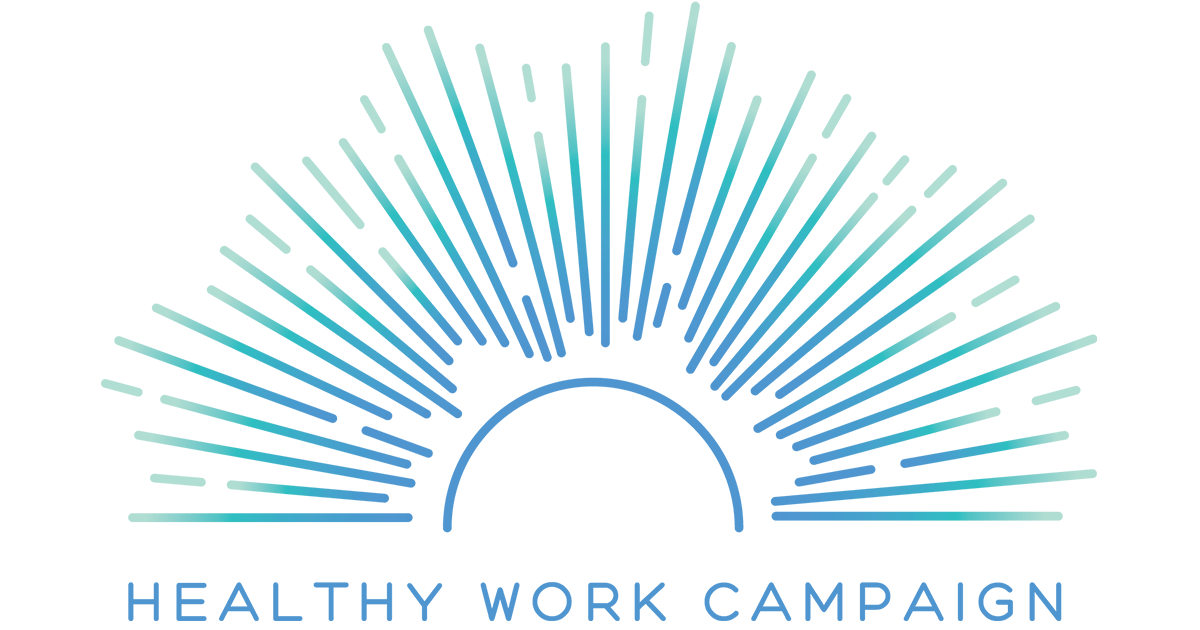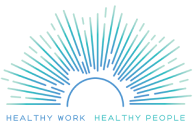Research
The Healthy Work Campaign (HWC)
is built upon a robust body of scientific research from a large, global community of occupational health researchers and organizations whose findings have informed our education campaign and related tools. For more research information, check out our parent organization website, unhealthywork.org.
Please find below relevant research we’ve divided into categories and a glossary to define words and phrases used on this site.
Research Articles
The following research articles and book chapters represent a selection of the most important and up-to-date scientific systematic review studies, meta-analyses, longitudinal cohort studies, and other important scholarship in the field which we have referenced in the Principles of Healthy Work.* It is not a comprehensive list, but includes key studies that show the link between work organization, work stressors and health outcomes including mental health/depression, high blood pressure, cardiovascular disease, productivity, and costs. (*The numbers below correspond to the numbered references in the Principles of Healthy Work.)
Work Stress and Health (General) (Ref. 1-2)
- Schnall P, Rosskam E, Dobson M, Gordon D, Landsbergis P, Baker D, (eds.). Unhealthy Work: Causes, Consequences and Cures. Amityville, NY: Baywood Publishing; 2009.
- Ganster DC, Rosen CC. Work Stress and Employee Health: A Multidisciplinary Review. Journal of Management. 2013;39:1085.
Work Stress and Depression (Ref. 3)
- Theorell T, Aronsson G. A systematic review including meta-analysis of work environment and depressive symptoms. BMC Public Health. 2015;15:738.
Work Stress and Cardiovascular Disease (CVD) (Ref. 4-5)
- Theorell T, Jood K, Jarvholm LS, et al. A systematic review of studies in the contributions of the work environment to ischaemic heart disease development. The European Journal of Public Health. 2016;26(3):470-477.
- Schnall PL, Dobson M, Landsbergis P. Globalization, Work, and Cardiovascular Disease. International Journal of Health Services. 2016;46(4):656-692.
Costs of Work Stress (Ref. 6-8)
- Jauregui M, Schnall P. Work, Psychosocial Stressors and the Bottom Line. In: Schnall P, Rosskam E, Dobson M, Gordon D, Landsbergis P, Baker D, eds. Unhealthy Work: Causes, Consequences and Cures. Amityville, NY: Baywood Publishing; 2009:153-167.
- Goh J, Pfeffer J, Zenios SA. The Relationship Between Workplace Stressors and Mortality and Health Costs in the United States. Management Science. 2015;March:1-12.
- Goh J, Pfeffer J, Zenios S. Across Different Demographic Groups Exposure To Harmful Workplace Practices Could Account For Inequality In Life Spans. Health Affairs. 2015;34(10):1761-1768.
Work Stress and Burnout (Ref. 9)
- Aronsson G, Töres Theorell, Grape T, et al. A systematic review including meta-analysis of work environment and burnout symptoms. BMC Public Health. 2017;17:264.
Work Stress and Blood Pressure (Ref. 10-11)
- Landsbergis P, Dobson M, Koutsouras G, Schnall P. Job strain and ambulatory blood pressure: A meta-analysis and systematic review. American Journal of Public Health. 2013;103(3):e61-e71.
- Gilbert-Ouimet M, Trudel X, Brisson C, Milot A, Vezina M. Adverse effects of psychosocial work factors on blood pressure: systematic review of studies on demand-control-support and effort-reward imbalance models. Scand J Work Environ Health. 2014;40(2):109-132.
Work Stress and Mortality (Ref. 12-13)
- Kivimäki M, Nyberg ST, Batty GD, et al. Job strain as a risk factor for coronary heart disease: a collaborative meta-analysis of individual participant data. Lancet. 2012;380:1491-1497.
- Kivimäki M, Ferrie JE, Batty GD, Nyberg ST, et al., for the IPD-Work consortium. Work stress and risk of death in men and women with and without cardiometabolic disease: a multicohort study. Lancet Diabetes Endocrinol. 2018; June.
Job Insecurity and Health (Ref. 14-20)
- Kim T, von dem Knesebeck O. Perceived job insecurity, unemployment and depressive symptoms: a systematic review and meta-analysis of prospective observational studies. Int Arch Occup Environ Health. 2016;89(4):561-573.
- Virtanen M, Nyberg ST, Batty GD, et al. Perceived job insecurity as a risk factor for incident coronary heart disease: systematic review and meta-analysis. British Medical Journal. 2013; 347:f4746.
- Vahtera J, Kivimaki M, Forma P, et al. Organizational downsizing as a predictor of disability pension: the 10-town prospective cohort study. J Epidemiol Community Health. 2005;59(3):238-242.
- Kivimaki M, Honkonen T, Wahlbeck K, et al. Organizational Downsizing and increased use of psychotropic drugs in employees who remain in employment. Journal of Epidemiology and Community Health. 2007(61):154-158.
- Quinlan M, Bohle P. Overstretched and unreciprocated commitment: reviewing research on the occupational health and safety effects of downsizing and job insecurity. Int J Health Serv. 2009;39(1):1-44.
- Vahtera J, Kivimaki M, Pentti J, et al. Organisational downsizing, sickness absence, and mortality: 10-town prospective cohort study. BMJ. 2004;328(7439):555.
- Laszlo KD, Pikhart H, Kopp MS, et al. Job insecurity and health: a study of 16 European countries. Soc Sci Med. 2010;70(6):867-874.
Job Rotation/Redesign and Health (Ref. 21)
- Yip B, Rowlinson S. Job Redesign as an Intervention Strategy of Burnout: Organizational Perspective. Journal of Construction Engineering and Management. August, 2009.
Workplace Support and Health (Ref. 22)
- Hämmig O. Health and well-being at work: The key role of supervisor support. Social Science & Medicine – Population Health. 2017;3: 393-402.
Effort-Reward Imbalance and Health (Ref. 23-24)
- Siegrist J. Chronic psychosocial stress at work and risk of depression: evidence from prospective studies. Eur Arch Psychiatry Clin Neurosci. 2008;258 Suppl 5:115-119.
- Siegrist J. Social Reciprocity and Health: New Scientific evidence and policy implications. Psychoneuroendocrinology. 2005;30(10):1033-1038.
Work-life Conflict and Health (Ref. 25-28)
- Hammer LB, Demsky. CA. Introduction to Work-life Balance. Workplace Well-being: Building Positive and Psychologically Healthy Workplaces. Available at: http://works.bepress.com/leslie_hammer/19/. West Sussex, England. 2014.
- Hammer LB, Kossek EE, Anger WK, Bodner T, Zimmerman K. Clarifying Work-Family Intervention Processes: The Roles of Work-Family Conflict and Family-Supportive Supervisor Behaviors. Journal of Applied Psychology. 2011;96(1):134-150.
- Moen P, Kelly E, Lee S, et al. Can a Flexibility/Support Initiative Reduce Turnover Intentions and Exits? Results from the Work, Family Health Network. Social Problems. 2017;64:53-85.
- Kelly E, Kossek E, Hammer L, et al. Getting there from here: Research on the effects of work-family initiatives on work-family conflict and business outcomes. The Academy of Management Annals. 2008;2(1):305-349.
Emotional Labor and Burnout (Ref. 29-30)
- Hülsheger UR, Schewe AF. On the costs and benefits of emotional labor: A meta-analysis of three decades of research. Journal of Occupational Health Psychology. 2011;16(3):361.
- Grandey AA, Rupp D, Brice WN. Emotional labor threatens decent work: A proposal to eradicate emotional display rules. Journal of Organizational Behavior. 2015;36(6):770-785.
Workplace Climate and Health (Ref. 31)
- Hall GB, Dollard MF, Winefield AH, Dormann C, Bakker AB. Psychosocial safety climate buffers effects of job demands on depression and positive organizational behaviors. Anxiety, Stress & Coping. 2013;26(4):355-377.
Organizational Justice and Health (Ref. 32-37)
- Kivimaki M, Ferrie J, Brunner E, et al. Justice at work and reduced risk of coronary heart disease among employees: the Whitehall II Study. Archives of Internal Medicine. 2005;165:2245-2251.
- Ferrie J, Head J, Shipley M, Vahtera J, Marmot M, Kivimaki M. Injustice at work and incidence of psychiatric morbidity: the Whitehall II study. Occup Environ Med. 2006;63:443-450.
- Elovainio M, Leino-Arjas P, Vahtera J, Kivimaki M. Justice at work and cardiovascular mortality: a prospective cohort study. Journal of Psychosomatic Research. 2006;61 271-274.
- Elovainio M, Heponiemi T, Sinervo T, Magnavita N. Organizational justice and health; review of evidence. G Ital Med Lav Erg. 2010;32.
- Ndjaboué R, Brisson C, Vézina M. Organisational justice and mental health: a systematic review of prospective studies. BMJ: Occupational and Environmental Medicine. 2012;69(10):694-700.
- Russell Cropanzano DEB, and Stephen W. Gilliland. The Management of Organizational Justice. Academy of Management Perspectives. 2007;21(4).
Incivility and Health (Ref. 38-40)
- Verkuil B, Atasayi S, Molendijk ML. Workplace Bullying and Mental Health: A Meta-Analysis on Cross-Sectional and Longitudinal Data. PLoS One. 2015;10(8):e0135225.
- Nielsen M. Outcomes of exposure to workplace bullying: A meta-analytic review. Work & Stress. 2012;26(4).
- Okechukwu CA, Souza K, Davis KD, Castro ABd. Discrimination, Harassment, Abuse and Bullying in the Workplace: Contribution of Workplace Injustice to Occupational Health Disparities. Am J Ind Med. 2014;57(5):573-586.
Precarious (Gig) Work and Health (Ref. 41-43)
- Tran M, Sokas RK. The Gig Economy and Contingent Work: An Occupational Health Assessment. J of Occ & Env Med. 2017;59(4):e63-e66.
- Benach J, Vives A, Amable M, Vanroelen C, Tarafa G, Muntaner C. Precarious Employment: Understanding an Emerging Social Determinant of Health. Annual Review of Public Health. 2014;35:229-253.
- Quinlan M, Sokas RK. Community campaigns, supply chains, and protecting the health and well-being of workers. Am J Public Health. 2009;99 Suppl 3:S538-546.
Shift Work and CVD (Ref. 44-45)
- Vyas M, Garg A, Iansavichus A, et al. Shift work and vascular events: systematic review and meta-analysis. British Medical Journal. 2012;345:e4800.
- Torquati L, Mielke G, Brown W, Kolbe-Alexander T. Shift work and the risk of cardiovascular disease. A systematic review and meta-analysis including dose-response relationship. Scand J Work Environ Health. 2018;44(3):229-238.
Long Work Hours and Health (Ref. 46-53)
- Dembe AE, Erickson JB, Delbos RG, Banks SM. The impact of overtime and long work hours on occupational injuries and illnesses: new evidence from the United States. Occup Environ Med. 2005;62(9):588-597.
- Major VS, Klein KJ, Ehrhart MG. Work Time, Work Interference With Family, and Psychological Distress. Journal of Applied Psychology. 2002;87(3):427-436.
- Milner A, Smith P, LaMontagne AD. Working hours and mental health in Australia: evidence from an Australian population-based cohort, 2001–2012. 72. 2015;8:573-579.
- Virtanen M SS, Fuhrer R, et al. Overtime work as a predictor of major depressive episode: a 5-year follow-up of the Whitehall II study. PLoS One. 2012;7:e30719.
- Virtanen M, Katriina Heikkilä, Markus Jokela, et al. Long Working Hours and Coronary Heart Disease: A Systematic Review and Meta-Analysis. American Journal of Epidemiology. 2012;176(7):586-596.
- Conway SH, Pompeii LA, Roberts RE, Follis JL, Gimeno D. Dose-Response Relation Between Work Hours and Cardiovascular Disease Risk: Findings From the Panel Study of Income Dynamics. J of Occ & Env Med Volume 58, Number 3, March 2016.58(3):221-226.
- Goh J, Pfeffer J, Zenios SA. Workplace stressors & health outcomes: Health policy for the workplace. Behavioral Science & Policy. 2015;1(1):43-52.
- Pencavel J. The Productivity of Working Hours. The Economic Journal. 2015;125(589).
Wages and Health (Ref. 54-56)
- Leigh JP, Du J. Are low wages risk factors for hypertension? European Journal of Public Health. 2012;22(6):854-859.
- Reeves A, Mckee M, Mackenbach J, Whitehead M, Stuckler D. Introduction Of A National Minimum Wage Reduced Depressive Symptoms In Low-Wage Workers: A Quasi-Natural Experiment In The UK. Health Economics. 2016:1-17.
- Tsao T-Y, Konty KJ, Wye GV, et al. Estimating Potential Reductions in Premature Mortality in New York City From Raising the Minimum Wage to $15. American Journal of Public Health. 2016;106(6):1036-1041.
Sick Leave and Health (Ref. 57-59)
- DeRigne L, Stoddard-Dare P, Collins C, Quinn L. Paid sick leave and preventive health care service use among U.S. working adults. Prev Med. 2017;99:58-62.
- DeRigne L, Stoddard-Dare P, Quinn L. Workers Without Paid Sick Leave Less Likely To Take Time Off For Illness Or Injury Compared To Those With Paid Sick Leave. Health Affairs (Project Hope). 2016;35(3):520-527.
- Stoddard-Dare P, DeRigne L, Collins CC, Quinn LM, Fuller K. Paid sick leave and psychological distress: An analysis of U.S. workers. The American Journal of Orthopsychiatry. 2018;88(1):1-9.
Selected Books and Book Chapters
Karasek, R. and Theorell T. (1992) Healthy Work: Stress, Productivity, and the Reconstruction Of Working Life. Basic Books. Reprint Edition.
Landsbergis PA, Dobson M, LaMontagne AD, Choi B, Schnall P, Baker DB. (2017) Chapter 14: Occupational Stress. In: Occupational and Environmental Health, edited by Barry S. Levy, David H. Wegman, Sherry L. Baron, Rosemary K. Sokas. Oxford University Press.
Landsbergis, P., et al. (2011). Occupational Health Psychology. In: The Occupational Environment: Its Evaluation, Control, and Management. D. Anna. Fairfax, VA, American Industrial Hygiene Association: 1086-1130.
Leigh, J. P., et al. (2000). Cost of Occupational Injuries and Illness. Ann Arbor, University of Michigan Press.
Marmot, M. and T. Theorell (1991). Social class and cardiovascular disease: the contribution of work. The psychosocial work environment: work organization, democratization and health. J. V. Johnson and G. Johansson. Amityville, NY, Baywood Publishing Company: 33-48.
Pfeffer, J. (2018). Dying for a Paycheck: How modern management harms employee health and company performance – and what can we do about it. New York, HarperCollins.
Sauter, S. and L. Murphy (2006). Approaches to job stress in the United States. Stress and Quality of Working Life: Current Perspectives in Occupational Health. A. Rossi, P. Perrewe and S. Sauter. Greenwich, CT, IAP: 183-197.
Sauter, S. L., et al. (2002). The Changing Organization of Work and Safety and Health of Working People: Knowledge Gaps and Research Directions. CDC, NIOSH.
Schnall PL, Dobson M, Landsbergis PA. (2017) Chapter 6: Work Stress and Cardiovascular Disease. In: The Wiley Handbook of Stress and Health: A Guide to Research and Practice edited by Cary L Cooper and James C Quick. Wiley-Blackwell.
Schnall, P., et al. (2009). Unhealthy Work: Causes, Consequences and Cures. Amityville, NY, Baywood Publishing.
Schnall, P., et al. (2000). The workplace and cardiovascular disease. Occupational Medicine: State-of-the-Art Reviews. Philadelphia, PA, Hanley and Belfus. 15.
Schnall, P. L. and R. Kern (1981). Hypertension in American society: An introduction to historical materialist epidemiology. The Sociology of Health and Illness: Critical Perspectives. P. Conrad and R. Kern. New York, St. Martin’s Press: 97-122.
Shimazu, A. by Akihito Shimazu (Editor), Rusli Bin Nordin (Editor), Maureen Dollard (Editor), Jodi Oakman (Editor) Psychosocial Factors at Work in the Asia Pacific: From Theory to Practice 1st ed. 2016 Edition.
Siegrist, J. (2002). Effort-reward imbalance at Work and Health. Research in Occupational Stress and Well-Being. P. L. Perrewe’ and D. Ganster. New York, JAI Elsevier. 2: 261-291.
Siegrist, J. and T. Theorell (2006). Socio-economic position and health: The role of work and employment. Social Inequalities in Health. J. Siegrist and M. Marmot. Oxford, Oxford University Press: 73-100.
Theorell, T., et al. (2015). Psychosocial factors in the prevention of cardiovascular disease. The ESC Textbook of Preventive Cardiology. S. Gielen, G. De Backer, M. Piepoli and D. Wood. London, Oxford University Press: 238-250.
Selected Classic Research Studies
Recommended work organization intervention studies
The following research articles are a small sample (not a systematic review) of scientific intervention studies that have addressed a number of work stressors in significant ways and cover a range of different occupations from several countries. In the future, the HWC is developing a comprehensive, searchable database of this extensive research literature as well as a summary of this evidence, so we can more completely recommend “best-practices” in addressing work stressors in your particular industry or organization.
Teachers
Government employees
Theorell T, Brisson C, Vézina M, Milot A, Gilbert-Ouimet M. 2015. Psychosocial factors in the prevention of cardiovascular disease. In: Gielen S, De Backer G, Piepoli M, Wood D editors. The ESC Textbook of Preventive Cardiology London: Oxford University Press. p 238-250. (Blood pressure reductions due to the intervention shown on pp. 246-8.)
Bus drivers
Hotel Housekeepers
Glossary of Terms
Absenteeism – The rate of “unscheduled absences” in the workplace, when employees do not arrive for work as scheduled. Absenteeism can result from work stress and illness as well as family and personal issues. Replacement of absent workers can increases costs and lower profits because it reduces productivity and often work quality.
Burnout – Burnout is a complex, but well-studied phenomenon at least since the 1970s. Researchers in social psychology, including Christina Maslach, the author of the most widely used research measure in the burnout field, have found that the occupational burnout syndrome has three major components: (1) emotional or vital exhaustion; (2) depersonalization/cynicism; (3) loss of professional efficacy. As of May 2019, the World Health Organization (WHO) recognizes burnout, not as a medical condition, but an “occupational phenomenon or syndrome.
Coworker Support – Working alone can be a significant source of distress. People need social interaction to remain healthy. Having coworkers who are unfriendly, competitive and who do not work well together is a serious source of stress at work and one that can be promoted by toxic work practices and cultures from the top levels of an organization.
Effort-reward imbalance – is a commonly studied psychosocial work stressor model developed by Johannes Siegrist. It is the idea that it is a stressful experience when you put in a high level of effort as a requirement of the job, and it is not matched with an appropriate level of reward (including fair pay, promotion prospects and recognition). ERI is related to poor mental health, including depression, adverse health behaviors, and heart disease.
High Demands – Having work that is too highly demanding means not having enough time to complete your tasks in a regular workday; having unrealistic deadlines; getting constantly interrupted; dealing with conflicting demands from multiple coworkers or managers; also, when the pace at which you are required to produce a widget, a report, serve a customer or other output is too fast to manage. These all result from how work is organized.
Job control (decision latitude) – When workers are not given some say over how they complete their work tasks, when they find every step “micro-managed” by supervisors, or every keystroke or interaction with customers monitored or scripted, workers lose a sense of autonomy. They have “low job control” which has been shown in many research studies to be significantly related to poor mental and physical health, including depression, high blood pressure and heart disease.
Job Insecurity – In a free market economy, such as the U.S., private sector companies have a lot of flexibility in hiring and firing. Restructuring, downsizing, and outsourcing causing layoffs have become all too common. Job loss is a reality that gives many workers a feeling that they may be next. Job insecurity is a perceived sense or the objective reality that you might lose your job at any time and it is related to a higher risk of depression and CVD.
Job Strain – is one of the most commonly studied psychosocial work stressor models and was developed by Robert Karasek (1990). It is having a job that has a combination of high demands (workload) and low job control and is related to burnout, depression, health behaviors (smoking, alcohol), obesity, high blood pressure, diabetes, and heart disease.
Lack of Promotion Opportunities – When you are stuck in a “dead-end” job, where you have a sense that there is no way forward or to advance your career, or to be given appropriate pay raises, this is a significant stressor. As we gain experience and skill in a job, a lack of appropriate rewards including recognition and promotion opportunities, can be especially stressful and is an aspect of effort-reward imbalance.
Lack of health insurance – Part-time workers, workers with non-standard employment arrangements (independent contractors) often don’t have access to employer group health plans. A lack of access to health insurance means you are less likely to get treated for a chronic illness in time to prevent more serious complications and have a higher mortality.
Long work hours – Americans work more hours annually than any other high-income, industrialized country. Over 25% of full-time salaried employees report working more than 55 hours per week. Mandatory overtime has become more common. Long work hours increase the risk for sleep disruption, depression and heart disease and are also associated with greater work-family conflict.
Low rewards – Inadequate pay threatens the economic security and the health and well-being of workers and their families. With a Federal minimum wage of $7.25/hour, the U.S. is ranked 12th in minimum wage, behind Australia, UK, Canada, Japan and most of Europe, just in front of Slovenia (13th). Low-wage jobs in retail and health care are the fastest growing sector of the U.S. economy.
Organizational Justice – When workers report that their organizations or supervisors treat them fairly (relational justice), and that decision-making procedures and outcomes are fair (procedural justice), they are much less likely to develop illnesses including depression, have less sleeping problems, greater cognitive abilities, better cardiovascular health and are less likely to be absent or leave the job.
Presenteeism – is a term describing how workers who come to work when ill, injured or experiencing chronic health problems, may, as a consequence, have lower productivity. Also called LPT or LWPT (lost [work] productive time), it includes: time not on task, decreased work quality and/or quantity. Data suggests that presenteeism may be more costly to employers than either absenteeism or short-term disability.
Repetitive work – It has been known for some time that monotonous, routine jobs that provide no variety – such as assembly-line work, data-entry, monitoring, etc. – can be at best “boring” but can also lead to repetitive motion injuries, burnout, and depression.
Shift work – Working nights or rotating shifts, common in many 24-hour industries, can disrupt sleep, family life, exercise and eating behaviors and has shown to increase the risk for CVD and mortality.
Sick/family leave and vacation time – More than 43 million workers, especially low-wage workers, do not have any paid sick leave or family leave benefits. Many workers who have to decide between an even lower paycheck and going to work sick, choose to go to work. 1 in 4 Americans in the private sector do not have any paid vacation time and many more don’t take their paid vacation.
Skill discretion – simply means that the job provides some creativity, and the opportunity to learn a variety of things or helps to develop and use your special skills or abilities. If your job is “low” in skill discretion, this means you have less opportunities to learn new things or practice a variety of tasks. It is a part of job control.
Supervisor support – At some time in our work careers we have experienced a “bad boss,” someone who yells or belittles you and your coworkers or someone that is willing to “throw you under the bus” rather than work together as a team. A lack of “support” from supervisors – not just emotionally but in terms of appropriate feedback and help with completing tasks – is a significant source of stress at work leading to poor health.
Work-family conflict – You come home too tired after work to do the things you enjoy. You have so much work that it takes time away from being with family or friends or personal interests. When your work role interferes with your role in the family or personal life, this is called work-family conflict. Studies have shown that it can negatively affect productivity as well as lead to burnout and depression. Work-life balance has been a growing concern in the United States where 38% of employees do not have paid sick/family leave and 23% have no paid vacation time.
Workplace sexual harassment – while there is not a universal definition of sexual harassment, it is behavior that occurs in the workplace; occurs because of a person’s sex and is related to or about sex; is unwelcome, unwanted, uninvited; and can affect the terms or conditions of employment or create a hostile work environment. It is illegal in the U.S., but at least 1 in 3 American women have been the victim of workplace sexual harassment. It can result in mental health challenges and job turnover.
Workplace discrimination violates the Civil Rights Act (1964) because of hostile behaviors or policies that intentionally or unintentionally target individuals due to their gender, race, religion, national origin, sexual orientation, disability or age. Yet while discrimination practices are down in the U.S., they continue to be surprisingly widespread.
Workplace bullying is “repeated mistreatment or abusive conduct that is threatening, humiliating, or intimidating.” (WorkplaceBullying.org) Almost 20% of Americans report experiencing bullying at work. Sixty million Americans are aware of and affected by bullying in their workplace and 40% of those bullied develop serious health problems. Women and minorities are more likely to be targeted. It is illegal in 31 states.






